TANK CLEANING WITH A ROTARY WASHING
MACHINE
PART II. A COMPLETE MODEL AND
EXPERIMENTS.
D.G.F. Verbeek
H.E.A. van den Akker
Kramers Laboratorium voor Fysische Technologie
Delft University of Technology
Prins Bernhardlaan 6
2628 BW Delft
Netherlands
Abstract
In part I of this paper [1] a model was derived
for the process of washing a dirty tank with a jetting rotary washing machine.
In this second part, an additional description is given for the draining
behaviour of the tank and its effect on the actual effluent concentration.
In order to verify the complete model of mobilising and draining various
laboratory and full-scale tests in different kinds of tanks were conducted.
The relative importance of the two processes of mobilising and draining
is discussed by means of analytical solutions for simplified versions of
the complete model. The rate at which soil is removed from the tank is
usually governed by two regimes, for short washing times the dilution process
at the drain of the tank dominates and for longer washing times the rate
determining effect is the slow mobilising of soil from the tank's internal
surface.
Introduction
In part I of this paper, soil has been defined as any kind of unwanted material present in a tank, like depositions, product residue, fouling etc. From the viewpoint of cleaning the tank, soil may be present in a tank in two essentially different ways: mobile and immobile. Immobile means sticking onto the tank's inner surface, and mobile means dissolved or dispersed in the washing water that runs down the walls or remains in the suction drain area of the tank.
The two ways of being present implies that tank cleaning is basically a two-step process:
First: the impinging jets mobilise the immobile soil sticking onto the inner surface of the tank; second: washing water with mobilised soil runs down the walls to the suction area where it is drained from the tank.
With a view of determining the tank's cleanliness it is more interesting to know the immobile amount of soil than the mobile amount, since usually the latter drains completely from the tank at the end of the washing process. On the other hand, direct measurement of this immobile amount
is rather impractical and will be very unreliable. During all of our tests, most of the immobile contamination remained out of reach of a human investigator on the tank's inner top surface distributed over an enormous area in many small spots corresponding to the meshes in the machine's washing pattern.
Alternatively, the total amount of soil in the
tank can only be determined indirectly by measuring the effluent concentration.
If the washing process is maintained long enough to get the tank as clean
as possible, the total amount of soil in the tank (mobile + immobile) as
a function of time can be calculated afterwards from the effluent concentration
data. In order to verify the power-law description for the mobilisation
of immobile soil, that was given in part I, it is necessary to know what
fraction of the total amount of soil in the tank is to be considered immobile.
For this reason in this second part of the paper an additional description
of the draining behaviour of the tank is given, which completes the tank
cleaning model.
Mobile and immobile soil behaviour
The total amount of soil, Mtot , in the tank is the sum of the amount of mobile soil, Mmob , and the amount of immobile soil, Mimm :
The fundamental equation that links effluent concentration, Ceff , to the total amount of soil in the tank, is

Substitution of eq. 1 gives




f as the flow rate of the tank washing machine(s), equation (7) can be written as



The development of the washing process in
time
As soon as the tank washing machine has been started, a film of water builds up on the walls which starts running down to the drain/suction area of the tank where it collects into a pool of liquid. This pool might be the main reason why mobile soil behaves as an ideal mixer and the volume of water contained in the pool might show up in the experiments as an apparent value of V.
The effluent of the tank remains zero until the pool has become large enough for the draining pumps to start working. This means that a certain time delay exists between the start of the washing machine and the start of the effluent. In a measurement situation it is handier to define t=0 as the moment the effluent starts running. For the description of equation 10 this has the following advantage:
Since the draining pumps may normally keep up with the flow rate of the tank washing machines, shortly after the effluent has started, feff may become equal to f and V may be constant. This means that the first term in equation (10), which only accounts for the building up of the pool, becomes zero shortly after the beginning of the effluent. By defining t=0 as the moment the effluent of the tank starts, this first term can be ignored completely, which reduces equation (10) to

Although it seems logical that tanks should be designed in such a way that they can be drained completely, this was certainly not always the case when Schuurmans performed his measurements. Most of his tests were conducted in older types of tanker ships. In earlier days of tanker transport it used to be common that after discharge of the cargo a certain amount stayed behind in the tank, out of reach of the suction pipe. This initial mobile amount of soil used to be much larger than the immobile amount sticking onto the inner surface. Combined with a commonly large value of V, it meant that mobilising was a relatively unimportant effect.
If the mobilising effect is neglected, equation 11 reduces to


The case Mmob>>Mimm leads to the dilution effect description of equation 12.
In the other case, after a sufficiently long washing
time, the pool adopts a quasi-steady behaviour. The dilution behaviour
decreases the original mobile amount of soil in an exponential way. The
immobile amount of soil is expected to decrease according to a power-law
function, which for larger values of t is always slower than the
exponential function. In the course of time, the originally mobile soil
flushes out and the water in the pool adopts the concentration, C,
of the washing water that runs down the walls. Since the mobile amount
of soil equals V Ceff V C and since it was also concluded
in part I of this paper that this concentration decreases one decade per
decade faster than the immobile amount of soil, it follows automatically
that after a sufficiently long time of washing Mmob «
Mimm and that the total amount of soil approaches the immobile
amount of equation 6 asymptotically.
The start of the washing process is usually dominated by the dilution effect, whilst the end of the washing process is dominated by the mobilisation effect. The transition between the two regimes is determined by the cleaning rate of both effects. The mobilising effect becomes more important than the dilution of the pool when

Calculation of the amount of soil in the
tank
The only practical measuring method for monitoring the amount of soil in the tank is by means of analyzing the soil concentration in the effluent. Integration of equation 6 gives the amount of soil that has left the tank. Subtracting this amount from the starting quantity yields, in theory, the quantity of soil remaining in the tank. In reality, however, this method is not accurate enough. Since the amount of soil usually drops over several decades during the washing process, it very quickly becomes smaller than the additive error in the calculation.
A simple way of avoiding this problem is to use the end of the washing process as boundary value and to integrate Ceff from the time of interest to the end of the washing time. By putting:

The total amount of soil in the tank as a function of time can be calculated from the concentration data with:

A second implication is that Mend,
the amount of soil in the tank at the end of the washing process, has to
be measured or estimated. If this value is left out of consideration, the
calculated result of Mtot exhibits a large systematic
error, especially near the end of the washing time.
In order to find this end quantity three basic methods were used:
1 After the mechanical washing had stopped, the tank was drained. All of the remaining soil was then washed out by hand using a fire hose paying special attention to all suspect dirty places. The volume of water used for this final cleaning multiplied by the concentration of a representative sample yields the value of Mend.
2 The washing process was maintained much longer than the commercial washing time, usually until the concentration in the effluent had reached the detection level of the analytical equipment.
3 An estimation was made by extrapolating the apparent power-law behaviour of the decaying concentration. Since for large times the concentration obeys

Experimental facilities and procedures
In order to develop and verify the above models,
more than a hundred washing tests were done in tanks of different shapes
and sizes varying from 30 to 2500 m3. The tank data of the tests
selected for this paper are summarized in table 1. Table 2 shows an overview
of the most important data of the selected tests.
| Tank | description | shape | length × width or diameter | height [m] | material |
| 1 | laboratory test | rectangular | 2.5 × 3.5 m2 | 3.75 | galvanized steel |
| 2 | land-based storage | vertical cylinder | 11 m | 11 | iron (corroded) |
| 3 | seagoing tanker cargo | cubical with vertical corrugations | 8 × 8 m2 | 8 | stainless steel |
| 4,5,6 | inland tanker cargo | rectangular with vertical corrugations | 9.5 × 9.4 m2 | 3.75 | stainless steel |
The test principle was very similar in all cases. The tank washing machine was suspended in the test tank on a flexible hose. Water was supplied by a pump at a pressure between 5 and 10 bar.
Four basic methods were used for collecting the effluent concentration data:
Method 1 The entire effluent of the tank was collected in a set of buckets and vessels of increasing size, ranging from 5 to 200 litre. The time data were calculated from the collected amount of water and the flow rate of the tank washing machine.
Method 2 Representative samples were taken from the effluent at a sample tap. The sample interval ranged from 15 seconds at the start to 5 minutes at the end of the washing process.
Method 3 As method 2; the samples, however, were taken in the tank from a slightly sloping flexible gutter that was sticked near the bottom onto the wall.
Method 4 The effluent was constantly measured
in a branch pipe and recorded by a PC.
The tank washing machines TZ 68 and TZ 82 are both commercially available tank washing machines that produce four cycles in a complete washing pattern. The machine denoted with GS was a modified TZ 68. Its internal gearing ratio had been changed according to the Golden Section method [4]. The purpose of this modification was to minimize the effect of the cycle-wise refining pattern and to obtain a cleaning performance that obeys the power-law model as closely as possible.
A specially built programmable tank washing machine
was used for many tests in the laboratory test tank. The rotations of the
nozzles about the two rotation axes were driven by stepping motors, which
enabled the imitation of any existing washing pattern at any speed, independent
of water pressure or flow rate. This way it was possible to vary just one
parameter in a test without the disturbing influence of uncontrollable
other parameters, such as differing internal flow resistances between machines,
different nozzle sizes and an uncontrollable pre-rotation at the start.
| series | no.of tests | fig. | tank | washing machine | Mend determined by method | sampling method |
| 1 | 6 | 1 | 1 | GS | 1 | 1 |
| 2 | 14 | 2,3 | 2 | GS | 2 | 3 |
| 3 | 6 | 4 | 3 | TZ 68 + GS | 2 | 2 |
| 4 | 3 | 5 | 4 | TZ 82 | - | 2 |
| 5 | 89 | 6 | 1 | programmable | 3 | 4 |
In all tests but those of series 4, the contaminating
soil was a 1 g/l solution of fluoresceine-sodium, which was sprayed in
a thin film onto the inner tank surface. Fluoresceine-sodium is a non-toxic
dye that is easily detectable up to very small concentrations. An ultra-violet
lamp illuminates a test tube with the sample. The fluorescent reaction
turns the UV-light into green visible light. The detected intensity of
green light relates linearly to the dye concentration.
Results
The measurements were all plotted on double logarithmic
axes. The vertical axis represents either the measured effluent concentration,
Ceff/Ceff0 , or the calculated
amount of soil in the tank, Mtot/Mtot0 , while
time is along the horizontal axis. Since for longer washing times both
quantities may obey a power law, the tail of each plot is expected to be
a straight line, whereas the respective slopes of the concentration and
soil amount curves should differ by 1 decade/decade.
Series 1
Figure 1 shows the result of one out of 6 washing tests in the laboratory test tank. The dots in the figure represent the measured and calculated values of Ceff/Ceff0 and Mtot/Mtot0. For the value of Ceff0 the concentration of the contamination sprayed on the walls was used. The smooth line following the concentration data was found by means of numerical integration of equation 10 and by "fitting" with V = 45 l , b= 0.69 and t0= 1 s. The smooth line following the amount of soil data is the result of the same fit and the substitution of Ceff in equation 5. In a separate test an attempt was made to measure actual dynamic hold-up of washing water in the tank. The washing machine was suddenly interrupted and from that moment on all of the effluent was collected and weighed. The measured amount of 55 l corresponds rather well to the fitted amount of 45 l. The difference could well be caused by the fact that the fraction of water that is streaming down the walls does not behave as an ideal mixer.
The extra line shows the comparison with the exponential
dilution model of Schuurmans (equation 12). At the start of the washing
process this description follows the amount of soil curve quite nicely,
but after 30 seconds the model does not longer apply. According to Schuurmans
model the same line should also describe the data of the effluent concentration.
This is clearly not the case but it would have been when the value of equation
9 is used for Ceff0. The starting effluent concentration
is completely determined by the starting mobilisation rate and the flow
rate of washing water.
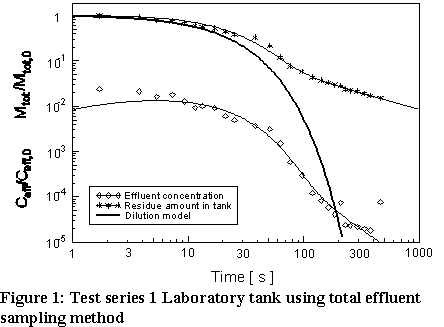
A total of 15 washing tests were conducted in two different cylindrical land-based storage tanks.
Since the tanks had no draining facilities and in order to minimise the influence of any hold-up of washing water in the tank the gutter sampling method was invented.
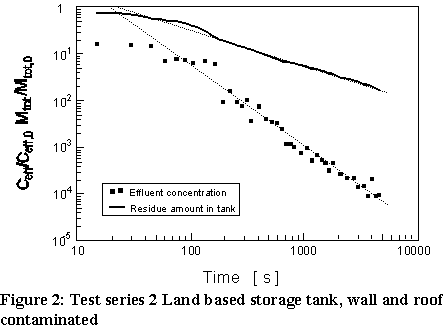
The result of two different tests in the smallest of the two tanks are shown in figures 2 and 3.
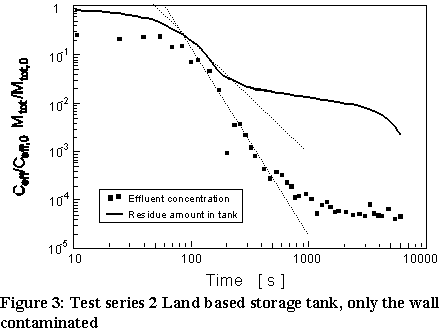
Figure 2 shows clearly the good approximation of the power-law model for describing the mobilisation of soil. This is proven by the straightness of the two curves. The two straight lines were independently fitted by means of linear regression. The difference in slopes agrees with the predicted value of one decade/decade (within 3%). The values of b=0.76 and of t0=20 s were used for fitting the concentration data and t0=23 s for the soil amount.
The visualisation showed that, with respect to
the tank top, the soil is much easier removed from the vertical walls.
To prove this, only the vertical wall was contaminated, whilst the top
surface of the tank was skipped. The measured result is shown in figure
3. Clearly the cleaning rate of the tank is much faster compared to the
former test. The figure hardly applies to the power-law model for two reasons.
The horizontal bending of the curves in the start of the washing process
may be due to a small dilution effect in the gutter. The horizontal bending
later in the washing process is due to the end contamination of the previous
test.
Series 3 The sea going tanker the 'Dutch Mate'
For the reason of determining a difference between the GS machine and the TZ 68, washing tests were conducted in a tank on board of the coastal tanker the Dutch Mate. Figure 4 shows the measured results of washing with the two different machines.
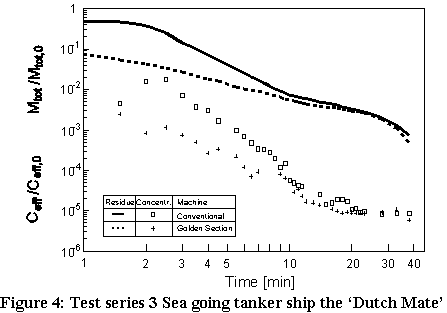
Series 4
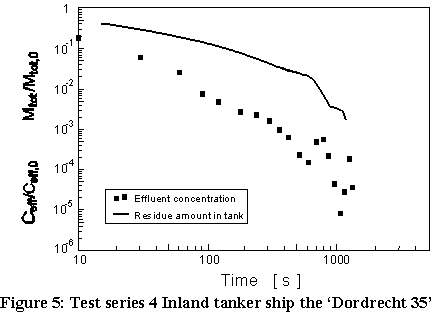
The measurements were conducted during normal
operation of the ship, hence, washing was maintained for 20 minutes only
rather than for the several hours that are actually needed for a reliable
measurement result. The deviations of the straight concentration line may
well be due to the cycle-wise refining of the washing pattern. The tail
of the M/M0 curve bends down, which is the result of
a missing Mend correction.
Series 5 The laboratory tank using sample method 4
A series of some 100 washing tests were conducted in the laboratory test tank using method 4 and the programmable machine. The tests were conducted in order to investigate the influence of washing pattern, rotation speed of the machine, tank size and soil viscosity. It goes beyond the purpose of this paper to discuss every test separately.
Figure 6 presents a typical example. The straightness of the two lines over so many decades is by far the best confirmation that the time decreasing concentration and amount of residue in a tank are following power-laws rather than exponential functions, as was previously assumed.
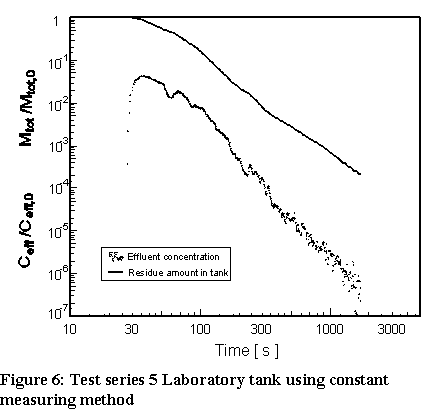
The rotation speed of the machine proved to be an important factor determining the washing efficiency. Almost the same amount of soil could be removed in a quarter of the time, using a quarter of the amount of washing water by means of speeding up the rotation of the machine by a factor 4. The only thing that seemed to matter was whether the washing cycle was complete or not. Further speeding up did not result in a further improvement; the cleaning rate of the tank became completely determined by the relatively slow dilution process.
The washing behaviour could be varied by means of changing the position of the washing machine. The cleaning rate behaves as that of a double sized tank when the machine is located near the largest wall and as that of a quadrupled tank when it is located in a corner. This artificially changed tank size did have a large effect on the cleaning behaviour. As a rule of thumb it can be stated that the same amount of washing water on the same amount of tank wall will result in the same amount of soil removed.
Unexpectedly, a significant influence of soil viscosity could not be demonstrated.
The effect of inhomogeneous building up of the
washing pattern is in most cases very small and complied to the predicted
behaviour in part I of this paper. During the building up of a cycle some
parts of the wall have - and some parts have not been washed which is less
efficient than the ideal power-law prediction. But as soon as the cycle
reaches its completion this negative effect disappears. Only when the machine's
washing pattern is very slowly progressing and when the cycle times are
much larger than the dilution time of the well, the effect is measurable.
Discussion
At the start of our investigations the only model available for describing the process of tank cleaning was the dilution model of Schuurmans and Schilder. Our first measurements on board of the Dutch Mate (fig. 4) proved that this model was far from ideal. Especially when the amount of soil in the tank was calculated from the concentration data it turned out to be higher by a factor of 300 than expected on the basis of the dilution model.
In response to the generally felt idea, that mobilisation
of soil should play an important role in tank cleaning, a new model was
developed. This so-called power-law model was presented in part I of this
paper. As experimental verification of the new model turned out to be a
lot more complicated than expected, the draining effect had to be taken
in consideration in order to complete the model. For the draining behaviour
Schuurmans' dilution description was adopted. The difference is that mobilised
soil now forms the input signal of the diluted volume of water.
The power-law model has been derived for describing the mobilisation behaviour of soil during the building up of the washing pattern. According to the model, the power-law behaviour of the decreasing amount of soil is the result of the slowly refining pattern by the intersection of the meshes with new tracks. Strictly speaking, for times longer than a complete cycle of the machine a theory is not jet available. In the stainless-steel tank of the Dutch Mate the curves changed in slope at the end of the cycle (after about 25 minutes). This complied with our expectations, since from that moment the pattern started overwriting itself. On the other, hand in the laboratory and the land-based tanks a similar transition was mostly not visible.
The experiments clearly demonstrated that the
two effects of mobilising and draining behaviour each play a different
role in the tank washing process. The rate of mobilising depends on numerous
parameters such as the kind of soil and the shape, size and wall material
of the tank and the cleaning capability of the tank washing machine. If
the tank has poor streaming down conditions to the tank's draining point
or a bad pumping efficiency, the dilution effect might become the bottleneck
for cleaning the tank. If the washing time is longer than 4 or 5 times
the dilution time V/f
this is usually never a problem.
The best verification of the model for short washing times was made in test series 1, where the complete model matched almost perfectly with the measurements. For longer washing times, when the dilution effect plays hardly any role, the best proof of a power-law mobilisation behaviour was demonstrated in the test of figure 6 by the two straight lines differing in slope by 1 decade/decade. Not in all cases the match could be demonstrated this accurately. One of the problems lies in the fact that verification of the straight lines requires a large number of decades both of the experimental time and of the concentration signal. The shortest interval times between the moment of turning on the water flow and the moment the first water returns as effluent from the tank, were obtained in the laboratory and the land based tanks, being in the order of 30 seconds. This meant that for two decades in time, at least an hour of measuring was required. The tanker ships responded typically within several minutes. Commercial concerns usually did not allow for the required long washing times.
Apart from being impractical and time consuming, measuring method 1 was the most reliable procedure. Since the time data were calculated from the amount of water collected in the buckets and vessels, the error in the response time was brought back to a few seconds only. Further the end quantity of soil, washed out by hand, was measured in the most reliable way by collecting all of the hand-wash water in a single vessel. Unfortunately, long washing times could not be effected using this method due to the limited number of vessels available.
The measurements on board of ships suffered from all kinds of disturbing and unexpected factors, varying from language problems with the deck-crew to non constant flow-rates of the effluent due to poorly-operating deepwell pumps or a rolling ship with a flat tank bottom. Insoluble soils tended to separate from the washing water in the discharge pipes, resulting in sampled concentrations of either 100% or 0%.
By means of visualisation tests it was clearly
demonstrated that the mobilising capability of the present tank washing
machines is far from ideal. The pattern meshes on the horizontal top surface
of the tank contained virtually all of the immobile substance in the tank.
Photographs of this behaviour were published elsewhere [6]. The cleaning
performance was unnecessarily slow, simply for the reason that the machine
was aiming the jets most of the time to wrong locations in the tank. If
the traditional rotational movement of the machine will be redesigned in
such a way that these dirty spots will be avoided, the efficiency of the
washing process will gain more than significantly in efficiency.
Conclusions
- Tank washing has to be described as a process
of mobilizing soil from the tanks inner surfaces and of draining mobile
soil from the tank. The soil that has been mobilised runs down the walls
to deepest point of the tank where it takes part in the draining process.
Both effects can form the bottle-neck for the rate at which substance is
removed from the tank.
- The amount of immobile soil on the inner surface
of the tank and the concentration of mobilised soil in the water that streams
down the walls both decrease in time roughly according to power-law functions.
The latter decreases approximately one decade/decade faster, which gives
the impression of a much cleaner tank than it is in reality.
- The draining process behaves very much like
an ideal mixer, meaning that the washing water containing mobilised soil
mixes up with a certain amount of liquid already present in the tank. If
the concentration of the mobilised soil is ignored, the amount of mobile
soil and the effluent concentration both decrease in time according to
exponential functions. The dilution rate depends on the flow rate of the
tank washing machines and the amount of liquid that can be considered well
mixed.
- Looking at the effluent of the tank, the cleaning
rate is usually first determined by the dilution effect and later by the
mobilising effect. Although both effects independently can have their own
starting quantities and decreasing rates, it is expected that after a sufficiently
long time of washing the mobilising effect forms the bottle-neck for the
cleaning rate. Normally, the transition between the two regimes happens
in a very early stage of the washing process.
- The best way of judging the cleanliness of a
tank is by considering the amount of immobile soil only. Even when the
transition between the two rate determining effects did not take place,
draining the tank usually removes all of the mobile substance. This might
change if the tank can not be emptied completely and a relatively large
amount of soil stays behind in the tank drain after discharge. In such
a case this extra amount of soil behaves as mobile substance and the starting
soil concentration in the effluent might be close to 100%; otherwise the
starting concentration is determined by the starting mobilisation rate.
Acknowledgements
This research project was conducted with financial
support from the Dutch Ministry of the Environment (VROM). We further received
financial support from the Vereniging van Onafhankelijke Tankopslag Bedrijven
(VOTOB), and from Toftejorg, Denmark. The assistance of Gebr. Broere B.V.,
Paktank Nederland B.V., and Toftejorg in preparing and conducting the full-scale
tests in the field is gratefully acknowledged.
Literature
1 D.G.F. Verbeek and H.E.A van den Akker, Tank Cleaning with a rotary washing machine Part I. A Power-law model describing mobilisation of product residues, submitted to Chem.Eng.Sci.
2 H.J.A.Schuurmans, J.G.. Schilder, Prewash procedures for chemical tankers, Monograph 35, The Netherlands Maritime Institute, june 1979,
3 H.J.A.Schuurmans, J.G.. Schilder, Residue calculation method for chemical tankers, Monograph 23, The Netherlands Maritime Institute, September 1978
4 D.G.F. Verbeek: `A method of, and apparatus for, cleaning a tank', American Patent no. American Patent no.07/839,758 also PCT/NL90/00150, 12 October 1990.
5 D.G.F. Verbeek & H.E.A. van den Akker, "Research on more efficient tank cleaning methods: a fundamental study", Petrochem 1(5), 1989, pp. 23-29.
6 H.E.A. van den Akker and D.G.F. Verbeek, Nieuw
uitspoelmodel helpt reinigen van tanks te optimaliseren, PolyTechnisch
Tijdschift Procestechniek, 47, 12, 1992, pp.34-38 (in Dutch).
Symbols
C concentration [kg m-3]
M amount of soil [kg]
t time [s]
t0 time constant for the power law model [s]
V Volume of the well mixed dynamic hold-up
of washing fluid [m3 ]
b constant in the exponent of the power law model [dim.less]
g a fit constant
f volume flow
rate [m3 s-1]
Subscripts
end at the end of the washing process
mob mobile
imm immobile
0 initial value, at the start of the washing process (may be in combination with mob, imm, tot or eff)
tot total (mobile +immobile)
eff of the effluent